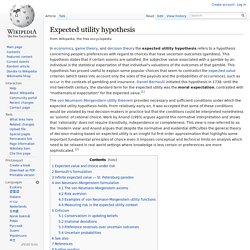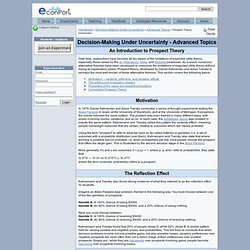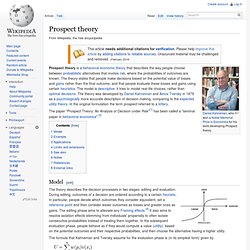

United States Sentencing Commission. Cercle des Associés en Risk Management. The Institute of Risk Management. Expected utility hypothesis. In economics, game theory, and decision theory the expected utility hypothesis refers to a hypothesis concerning people's preferences with regard to choices that have uncertain outcomes (gambles).

This hypothesis states that if certain axioms are satisfied, the subjective value associated with a gamble by an individual is the statistical expectation of that individual's valuations of the outcomes of that gamble. This hypothesis has proved useful to explain some popular choices that seem to contradict the expected value criterion (which takes into account only the sizes of the payouts and the probabilities of occurrence), such as occur in the contexts of gambling and insurance. Daniel Bernoulli initiated this hypothesis in 1738. Until the mid twentieth century, the standard term for the expected utility was the moral expectation, contrasted with "mathematical expectation" for the expected value.[1] Expected value and choice under risk[edit] Bernoulli's formulation[edit] The St. For . Handbook - Decision-Making Under Uncertainty - Prospect Theory.
Over time, researchers have become all too aware of the limitations of expected utility theory, especially those raised by the St.

Petersburg, Allais, and Ellsberg paradoxes. As a result, numerous alternative theories have been developed to overcome the limitations of expected utility theory without losing its explanatory power. Prospect theory, developed by Daniel Kahneman and Amos Tversky is perhaps the most well-known of these alternative theories. This section covers the following topics: In 1979, Daniel Kahneman and Amos Tversky conducted a series of thought experiments testing the Allais Paradox in Israel, at the University of Stockholm, and at the University of Michigan. More generally, if x and y are outcomes; 0 < p,q,r < 1, where p, q, and r refer to probabilities, they state that: (y, p*q) (x, p) (y, p*q*r) (x, p*r); where the term (outcome, probability) refers to a prospect.
Kahnemann and Tversky also found strong evidence of what they referred to as the reflection effect. Prospect theory. The paper "Prospect Theory: An Analysis of Decision under Risk"[1] has been called a "seminal paper in behavioral economics".[2] Model[edit] The formula that Kahneman and Tversky assume for the evaluation phase is (in its simplest form) given by where is the overall or expected utility of the outcomes to the individual making the decision, are the potential outcomes and their respective probabilities. is a function that assigns a value to an outcome.

Is a probability weighting function and captures the idea that people tend to overreact to small probability events, but under react to large probabilities. Example[edit] To see how Prospect Theory can be applied, consider the decision to buy insurance. 1. 2. These expressions can be computed numerically. In losses, and hence the insurance looks unattractive. In this example, a strong overweighting of small probabilities undo the effect of the convexity of in losses: the potential outcome of losing $1,000 is overweighted. Applications[edit]